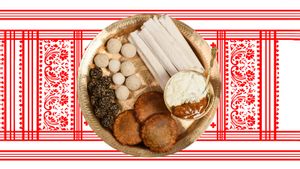There are two kinds of love. The one that hits you instantly, and the one that grows on you until you have no excuse but to embrace it. In the case of food, it’s almost always the first one, because if you don’t like the food in the beginning, you just don’t eat it anymore. And then you grow up. The flavours from childhood that made you cringe in horror, that mother tried in vain to feed you, revisit you, and you find yourself falling in love with them.
For many children in Assam, that dish is Khar. Unique to Assamese cuisine, it is both an ingredient as well as a dish in itself. In a cuisine that uses a lot of acidic ingredients—our penchant for tanginess is well known—Khar is a peculiar ‘alkaline’ dish.
Khar is a traditional Assamese dish, where the principal ingredient is also called Khar. The ingredient is obtained by filtering water through the ashes of sun-dried banana peel. A phoenix of an ingredient that literally rises out of the ashes to turn into a delectable delicacy. Khar can be mixed with a lot of other ingredients to make different variations of the dish.
Khar is mainly cooked with mushy and wet vegetables for the fine aroma to emerge. Some popular ones are raw papaya, banana stem, different gourds, green leafy vegetables like spinach, pulses and even fish. Just think of it as a garnish, except that it changes the whole flavour of the dish. When you’re not in the mood to cook, just add a few drops of mustard oil to raw Khar, to make Kharoli, and you’re done!
It is a love affair that has evolved over the years, starting with childish indifference to one that has grown to be the strongest bond to the cuisine of my ancestors. A word of advice. It is generally recommended to not combine a tangy preparation when you’re eating Khar. Hence, we start our meal with Khar and rice, move on to dal and veggies, then meat and we end it with Tenga and rice, hence spacing out the alkali from the acidic.
A personal favourite is a Khar-based Rohu fish head preparation. The aroma wafting from the kitchen is so intoxicating, you’ll stop in your tracks to take in the delicious smell. Just toss some fried Rohu fish head pieces in the normal recipe preparation and it is done!
Khar Murighonto (Rohu fish head preparation with Khar)
Ingredients
- 1 medium-sized green (raw) papaya, chopped
- 1 medium-sized fish head of either Rohu or Catla
- 1 tbsp mustard oil
- 1 tbsp cumin seeds, whole
- 1 tbsp ginger, grated
- 2 tsp Khar (recipe mentioned above*) or 1 tbsp baking soda
- Salt to taste
- Turmeric, optional
Method
- Marinate the fish head in salt and turmeric and keep aside for an hour.
- Heat mustard oil and fry the fish head and keep it aside.
- In the same oil, add the whole cumin seeds.
- Add the papaya and salt. Fry for a few minutes.
- Add the khar/baking soda and grated ginger and mix well.
- After 2-3 mins, add 3 cups of water and boil for a while.
- Just before the water comes to a boil, add the fish head after breaking it into small pieces. You can add turmeric for a bit of colour as well.
- Cook on a low to medium flame for around 10 minutes until the water level comes down and the gravy thickens. Best served with steamed rice.



